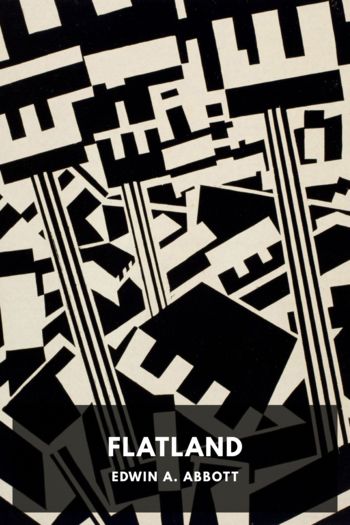Flatland Edwin A. Abbott (most romantic novels .txt) 📖

- Author: Edwin A. Abbott
Book online «Flatland Edwin A. Abbott (most romantic novels .txt) 📖». Author Edwin A. Abbott
Elsewhere in Flatland, colour is now nonexistent. The art of making it is known to only one living person, the Chief Circle for the time being; and by him it is handed down on his deathbed to none but his successor. One manufactory alone produces it; and, lest the secret should be betrayed, the workmen are annually consumed, and fresh ones introduced. So great is the terror with which even now our aristocracy looks back to the far-distant days of the agitation for the Universal Colour Bill.
XI Concerning Our PriestsIt is high time that I should pass from these brief and discursive notes about things in Flatland to the central event of this book, my initiation into the mysteries of Space. That is my subject; all that has gone before is merely preface.
For this reason I must omit many matters of which the explanation would not, I flatter myself, be without interest for my readers: as for example, our method of propelling and stopping ourselves, although destitute of feet; the means by which we give fixity to structures of wood, stone, or brick, although of course we have no hands, nor can we lay foundations as you can, nor avail ourselves of the lateral pressure of the earth; the manner in which the rain originates in the intervals between our various zones, so that the northern regions do not intercept the moisture from falling on the southern; the nature of our hills and mines, our trees and vegetables, our seasons and harvests; our alphabet and method of writing, adapted to our linear tablets; these and a hundred other details of our physical existence I must pass over, nor do I mention them now except to indicate to my readers that their omission proceeds not from forgetfulness on the part of the author, but from his regard for the time of the reader.
Yet before I proceed to my legitimate subject some few final remarks will no doubt be expected by my readers upon those pillars and mainstays of the Constitution of Flatland, the controllers of our conduct and shapers of our destiny, the objects of universal homage and almost of adoration: need I say that I mean our Circles or Priests?
When I call them Priests, let me not be understood as meaning no more than the term denotes with you. With us, our Priests are administrators of all business, art, and science; directors of trade, commerce, generalship, architecture, engineering, education, statesmanship, legislature, morality, theology; doing nothing themselves, they are the causes of everything worth doing, that is done by others.
Although popularly everyone called a Circle is deemed a Circle, yet among the better educated classes it is known that no Circle is really a Circle, but only a Polygon with a very large number of very small sides. As the number of the sides increases, a Polygon approximates to a Circle; and, when the number is very great indeed, say for example three or four hundred, it is extremely difficult for the most delicate touch to feel any polygonal angles. Let me say rather, it would be difficult: for, as I have shown above, Recognition by Feeling is unknown among the highest society, and to feel a Circle would be considered a most audacious insult. This habit of abstention from Feeling in the best society enables a Circle the more easily to sustain the veil of mystery in which, from his earliest years, he is wont to enwrap the exact nature of his perimeter or circumference. Three feet being the average perimeter it follows that, in a Polygon of three hundred sides each side will be no more than the hundredth part of a foot in length, or little more than the tenth part of an inch; and in a Polygon of six or seven hundred sides the sides are little larger than the diameter of a Spaceland pinhead. It is always assumed, by courtesy, that the Chief Circle for the time being has ten thousand sides.
The ascent of the posterity of the Circles in the social scale is not restricted, as it is among the lower Regular classes, by the law of Nature which limits the increase of sides to one in each generation. If it were so, the number of sides in a Circle would be a mere question of pedigree and arithmetic, and the four hundred and ninety-seventh descendant of an Equilateral Triangle would necessarily be a Polygon with five hundred sides. But this is not the case. Nature’s law prescribes two antagonistic decrees affecting Circular propagation; first, that as the race climbs higher in the scale of development, so development shall proceed at an accelerated pace; second, that in the same proportion, the race shall become less fertile. Consequently in the home of a Polygon of four or five hundred sides it is rare to find a son; more than one is never seen. On the other hand the son of a five-hundred-sided Polygon has been known to possess five hundred and fifty, or even six hundred sides.
Art also steps in to help the process of the higher evolution. Our physicians have discovered that the small and tender sides of an infant Polygon of the higher class can be fractured, and his whole frame reset, with such exactness that a Polygon of two or three hundred sides sometimes—by no means always, for the process is attended with serious risk—but sometimes overleaps two or three hundred generations, and as it were doubles at a stroke, the number of his progenitors and the nobility of his descent.
Many a promising child is sacrificed in this way. Scarcely one out of ten survives. Yet so strong is the parental ambition among





Comments (0)